A passive house, compared to a traditional house, has very low energy consumption as well as a minimum impact on the environment. These buildings, also known as passivhouses, are starting to be seen in Spain and they are defined as houses that are constructed considering the environment. In this blog, we already wrote an article about the advantages of sustainable housing. In it, we pointed out that our real estate system must make a commitment with sustainability. It is obvious that, in the future, housing will be sustainable. The only possible scenario is that of a real estate system which respects the environment and is structured around sustainability. In our country, state-of-the-art houses are already being built and they have 75% less energy consumption than traditional property. Apart from the economic savings for the owner of the house, we must also consider the fact that these passive houses reduce considerably the greenhouse gas emissions. This really means giving our planet a break. Let´s analyse it in detail.

FIVE CHARACTERISTICS OF A PASSIVE HOUSE
Houses with a passivhouse stamp have the latest technology in Europe which certifies very low energy consumption. It is a kind of architecture that makes the most of all building materials, always of the very best quality, and also aims at creating the minimum environmental impact. The main passive house characteristics are:
01. Great insulation so as to minimize the loss of temperature in the house. Thermal bridges can be reduced up to ten times in a passive house.
02. Great quality windows and doors so as to minimize the loss of temperature.
03 Controlled ventilation so as to renew the air frequently.
04 Maximum sun protection so as avoid temperature increase during times of heat.
05 Air tightness to avoid air infiltrations and undesired draughts.

BUT, HOW MUCH DOES A PASSIVE HOUSE COST?
This is the question we ask ourselves. How much will it cost to have a passive house? It is estimated that a passive house is 15% more expensive than a conventional one. However, we must bear in mind a very important issue: the cost of a passive house is gradually reduced as the years go by. This is because, thanks to its energy savings (heating expenses may be 90% lower), one can amortize the investment in ten years. We must not forget that in order to have a passivhouse stamp the house must pass very rigorous controls. Therefore, if a house has the passivhouse stamp, it receives the guarantee of energy and economic savings.




 Spanish
Spanish English
English